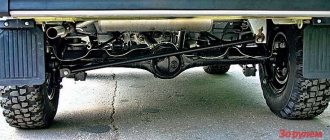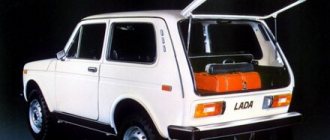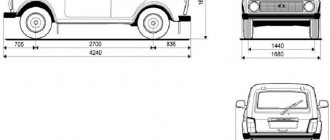Background and start of assembly
The Russian (formerly Soviet) light SUV Niva is considered a legendary brand, well known not only in Russia, but also in many foreign countries; the first VAZ-2121 model in this series began to be produced from the beginning of April 1977.
Although over the many years of production the car has undergone many various modernizations, its appearance has remained well recognizable.
Now the all-terrain vehicle is manufactured under the Lada brand, and the Lada 4x4 Bronto is a tuning version with more “advanced” off-road characteristics and a slightly modified exterior.
The assembly of the LADA 4×4 Bronto model is carried out at a subsidiary of the Volzhsky Automobile Plant called VIS-AVTO, which merged with PJSC PSA Bronto into one company in 2012.
The car modification has been produced since July 2022; it is an improved version of the well-known Lada under the name “Lynx” (2009-2012 production).
Modifications of the short-wheelbase Niva
VAZ-2121 "Niva"
VAZ-2121 “Niva” (export name Lada Niva 4×4) - the base model with the VAZ-2121 engine (1.6 l, 75 hp, 116 Nm) and 4-speed. Checkpoint. Several prototypes of the VAZ-E2121 were created in 1972-1975. At the end of 1976, a pilot production batch of Niva was produced. The model was serially produced from April 1977 to 1993.
VAZ-21211 (Lada Niva 1.3)
VAZ-21211 (Lada Niva 1.3) - export modification with the VAZ-21011 engine (1.3 l, 69 hp, 92 Nm). Produced since 1978 for countries with increased taxes on engines with a volume of more than 1500 cm³ (mainly the Benelux countries and Southern Europe). It was in limited demand due to the low torque of the engine off-road and poor dynamics on regular roads.
VAZ-21212 (Lada Niva 4×4)
VAZ-21212 (Lada Niva 4×4) - export right-hand drive modification. Produced in limited quantities, primarily for the English market. It is known about the sale of a small batch of right-handed Nivas to Japan, where Soviet cars had neither previously nor later penetrated.
VAZ-2122.600 “River”
VAZ-2122.600 “River” is an army amphibious vehicle using VAZ-2121 units. In 1976-1985. Several prototypes of the amphibian with a utilitarian sealed open 2-door body were developed. In 1987, a modified model of the VAZ-2122.600 “Reka” passed state tests, but the amphibian was not mass-produced due to conversion.
VAZ-21213 "Taiga"
VAZ-21213 (the original name “Taiga” did not stick) is a restyled Niva model with a redesigned rear part of the body with a lower loading height (a different shape of the rear door and rear lights), a more powerful and high-torque VAZ-21213 engine (1.7 l , 81.8 hp, 125 Nm) with a Solex carburetor and a contactless ignition system (both reduce fuel consumption), an aluminum radiator, and much more. In 1993, a transitional batch was produced with a standard VAZ-2121 engine.
VAZ-21214 (LADA 4×4)
VAZ-21214 (LADA 4×4) - modification of model 21213 with the VAZ-21214 engine (1.7 l, 81.8 hp, 127.5 Nm) equipped with central fuel injection. Since 2002, this model has been equipped with a VAZ-21214-10 (Euro-0) engine with distributed fuel injection, upgraded in 2006 to Euro-2 (21214-20) and in 2008 to Euro-3 (21214- thirty). Since 2006, in accordance with the agreement on the GM-AvtoVAZ joint venture, it was renamed LADA 4x4 3-door..
VAZ-21215
VAZ-21215 is an export version with a Peugeot XUD 9SD diesel engine, produced in 1999-2007. The modification was produced in small series for export, so the standard assembly included an improved body kit (bumpers, spoilers, linings, alloy wheels, etc.).
VAZ-21216
VAZ-21216 is an export version of model 21213 with right-hand drive and a VAZ-21213 carburetor engine.
VAZ-21217
VAZ-21217 is an export version of model 21213, with a VAZ-21011 engine (1.3 l).
VAZ-21219
VAZ-21219 is a transitional combined modification with a body and suspension from the VAZ-2121 and a 1.7-liter engine and transmission from the VAZ-21213. The interior and rear window washer reservoir were also retained from the VAZ-2121. Produced in 1993-1994.
VAZ-2121B
VAZ-2121B is an armored cash-in-transit vehicle based on the VAZ-2121. It was created in 1992 by specialists from the VAZ subsidiary. Produced in limited edition in 1992-1993. Served as the starting point for the creation of the BRONTO Force family of armored vehicles.
VAZ-2121F
VAZ-2121F is an export commercial version based on the VAZ-2121 and 21213 models with a van-type body. The rear of the cabin has been converted into a cargo area by replacing the side windows (retained on the tailgate) with metal panels and removing the rear seat and trim. Tubular protection is installed behind the front seats to prevent cargo from shifting during braking. The van version of the Niva is manufactured in small batches at the AvtoVAZ production plant for delivery exclusively to the markets of non-CIS countries, where local legislation provides tax incentives for such commercial vehicles.
LADA 4x4M
LADA 4x4M is a modernized version of the VAZ-21214, the gradual development of which is expected from 2009. Lighting devices, interior, transmission components have been changed. Some components were used from Chevrolet Niva.
Differences between the Bronto version and the standard model
LADA 4×4 Bronto is an all-wheel drive off-road vehicle with a three-door body, four seats, with two rows of seats.
This modification differs from the basic VAZ SUV:
- roof rails built into the roof;
- original plastic radiator grille;
- wheels of larger diameter;
- round foglights integrated into the front bumper (in the Image package);
- front body overhang reduced by 10 cm;
- plastic bumpers (for Image) and body kit throughout the body;
- reinforced wheel drives and rear axle beam;
- a different final drive number to improve traction;
- higher ground clearance;
- cut off wheel arches, thereby increasing the departure angle;
- the presence of self-locking screw-type differentials.
In LADA Bronto, the gear ratio of the main pairs of both axles is 4.1 (versus 3.9 for the standard version), “lifted” rear spring supports provide a higher lift of the body above the road surface.
The rear suspension shock absorbers have a stroke increased by 50 mm, the front springs are taken from the armored Niva, and spacers are installed under the ball joints.
Also, the wheel track width on the tuned car is 80 mm larger, and the car is equipped with 235/75 R15 wheels with a special “evil” tread.
The interior space of the Bronto has almost no differences from the interior of the regular Lada 4x4 model; it is characterized by an inexpressive, simple design and finishing materials of not the highest quality.
Price of factory Niva Bronto Lynx
There are 3 modifications:
- Niva Bronto Lynx in three-door version;
- Niva Bronto Lynx in a five-door version;
- Niva Bronto Lynx is a five-door with a large trunk, popularly known as VAZ 2131.
The Niva Bronto Lynx was first introduced in 2009. The name is so unusual - Lynx came from a competition held for fans of off-road riding. Many voted and decided to name this off-road modification Lynx.
At the Niva Bronto Lynx plant, all tests were carried out, which is why the full-fledged factory SUV is certified and mass-produced. The basis, of course, is the Niva 4x4.
The Lynx is specially modified specifically for driving on severe off-road conditions. The car was tested by many organizations and came to the conclusion that the LADA NIVA 4×4 “Lynx” is one of the best production cars in the world.
This modified SUV is equipped with R-15 wheels with an additional 4 cm of offset outward, which means that the track increases by 8 cm.
Tires may be different, but the best fit are YaShZ Ya-569 235/75/R15 29″ and Cordiant off-road 235/75/R15 29″ tires.
- The starting price of the Niva Bronto Lynx in the first modification without additional options is 644,400 rubles. If the car is painted in camouflage, its price will increase to 708,200 rubles;
- the cost of the 2nd modification of the Niva Bronto Lynx starts from 688,000 rubles, in camouflage - 767,600 rubles;
- The 3rd modification costs 723,000 rubles without additional options, in camouflage - 802,600 rubles.
If we take the top one with the maximum number of options, then the price of such a Niva will be 950,000 rubles.
As you can see, the price is simply astronomical, and for the emptiest version of the Niva Lynx. If we take into account that the new Niva 3D costs 439,900 rubles, then the difference is 204,500 rubles. We decided to calculate how much it would cost to make a 3D Niva from a standard Niva - Niva Lynx 1 in a two-door version.
Having tuned Niva 3D we will get Niva Lynx 1, for this you will need to buy the following parts:
- Flexible Kit arch extensions - 4,000 rubles;
- locks 2 pieces - 22,000 rubles;
- main pair 4.1 - 6200 RUR;
- elevator kit 11,000 RUR;
- tires Cordiant Off Road 235/75 R15 - 18,800 rub.
- KiK Angara wheels 6.5x15 - 12,800 rub.
Cost of work done:
- replacement of the main pair - 8000 rubles;
- installation of locks - 4000 rubles;
- reinforcement of the rear axle - 9000 rubles;
- installation and configuration of lift kit 7000;
- cutting arches and installing extensions - 6000 rub.
The price of converting a standard new Niva 3D into a Niva Lynx 1 economy option is 108,800 rubles, totaling with the price of the car is 549,000 rubles. Of course, it won’t be possible to make them exactly one to one, but the characteristics will be approximately the same. The cost of the alteration is approximate, taking into account all work performed in the service center. Installing spare parts yourself will significantly reduce the price.
If you take a good used Niva 3D from 2007 with an injection engine and power steering, for about 200,000 rubles, then the total price of reworking the car will be 310,000 rubles. And this is no longer as expensive as for an irreplaceable SUV.
And also interesting: Chevrolet Niva fuses with a description of the block diagrams. Niva cigarette lighter fuse.
The price of cars and tuning may vary slightly depending on the region, but we managed to get an approximate amount of costs.
Engine and transmission
The Lada 4×4 Bronto is equipped from the factory with only one type of power unit - a 1.7-liter VAZ-21214 gasoline engine with distributed fuel injection and hydraulic pushers.
Technical characteristics of this internal combustion engine:
- exact volume – 1690 cm;
- placement of the engine under the hood is longitudinal;
- location/number of cylinders – in line/4;
- power max. – 83 l. With.;
- torque max at 4000 rpm – 129 N*m;
- valves in each cylinder - 2;
- compression ratio – 9.3;
- cylinder diameter/piston stroke – 82/80 mm.
The cylinder block of the VAZ-21214 engine is cast from cast iron, the material of the block head is aluminum alloy. With such an engine, the Lada SUV can accelerate to a maximum of 137 km/h and reach “hundreds” in 18 seconds.
Recommended fuel is AI-95 gasoline, the engine is in compliance with Euro-4 environmental standards, average fuel consumption per 100 km is about 12 liters.
The 1.7-liter engine is paired with a 5-speed manual transmission, and a manually controlled transfer case is also installed. The wheel drive is permanent all-wheel drive, there are a number of reduction gears.
VAZ-2123 and Chevrolet Niva
VAZ-2123
VAZ-2123 is a Russian compact SUV of the second generation, pilot production batches of which were produced at VAZ in 2001-2002. It maintained continuity with the old Niva in terms of units and received a new, more spacious five-door body. AvtoVAZ did not have the funds to introduce it into mass production, and as a result, the license for the VAZ-2123 and the rights to the Niva brand were sold to the General Motors concern.
Chevrolet Niva (Chevrolet Niva)
American designers made about 1,700 changes to the design of the VAZ-2123, which allowed the Chevrolet Niva to be considered an independent design. Since September 2002, after the launch of a joint production line with General Motors (OJSC JV GM-AvtoVAZ), the VAZ-2123 began to be produced under the Chevrolet Niva brand.
Chevrolet Niva (Chevrolet Niva) FAM-1
The first batch of Chevrolet Niva FAM-1 cars was released in the spring of 2006, production began in November 2006. The car received the VAZ-21236 index and was produced in a single GLX configuration. The car was equipped with an Opel Z18XE engine (1.8 l, 122 hp) and a 5-speed Aisin manual transmission (from Suzuki Grand Vitara), a new transfer case in a single unit with the gearbox. At the end of April 2008, the Chevrolet Niva FAM-1 model was discontinued. In two years, only about a thousand Chevrolet Niva FAM-1 were made and sold.
Chevrolet Niva Trophy (Chevrolet Niva Trophy)
There is a tuning modification “Trophy” (Chevrolet Niva Trophy), adapted for off-road use. The main differences from the basic configuration include a mechanical chain tensioner instead of a hydraulic one, installation of a snorkel to avoid water hammer when passing fords, forced shutdown of engine cooling fans, transmission breathers in the engine compartment, self-locking limited-slip differentials in gearboxes, main pairs with a gear ratio of 4.3 (instead of 3.9) in the transmission, a mechanism for attaching an electric winch.
Chevrolet Niva (Chevrolet Niva), restyling 2009
On March 11, 2009, GM-AvtoVAZ made a long-awaited update to the Chevrolet Niva. The new modification received the VAZ-212300-55 index. The famous Italian design studio “Bertone” was involved in creating the new car design. After the update, the appearance of the car began to correspond to the unified corporate style of Chevrolet, while the manufacturer retained the parameters of geometric cross-country ability.
Technical characteristics of LADA 4×4 Bronto
The Bronto version from VIS-AUTO is a compact SUV with a length of 3.74 m, width and height of 1.713 and 1.74 m, respectively.
The car has a wheelbase of 2200 mm and ground clearance of 24 cm (under the front axle - 26 cm), other technical characteristics of the car:
- Body type – SUV, three-door;
- wheel track (front wheels) – 1478 mm;
- wheel track (rear wheels) – 1468 mm;
- curb weight – 1285 kg;
- total weight – 1610 kg;
- permissible weight of a towed trailer – 300 kg (with a brake system – 300 kg);
- gas tank capacity – 42 l;
- trunk volume standard/maximum – 265/585 l;
- the weight of the cargo on the roof (with the rack installed) is no more than 50 kg.
The Bronto model is equipped with power steering and a steering gear with a worm gear.
The front suspension here is independent, has a standard stabilizer and double wishbones for passenger cars, the rear suspension is of a dependent type, with four longitudinal and one transverse links.
The brakes on the front wheels are equipped with non-ventilated discs, and drums are installed at the rear.
Design features of Fora
The total curb weight of the vehicle has increased by 75 kg compared to the standard version of the Niva. According to the experts who developed the model, a slight increase in weight made it possible to use the existing chassis design without the need to change the entire suspension. Only the springs and shock absorbers were replaced. The braking system remains unchanged: disc brakes at the front, conventional drums at the rear. The model is equipped with power steering.
Under the hood, a 1.7-liter power unit, standard for all modifications of the Niva, is installed. Nothing significant was added to the design of the engine, although it is frankly weak for an SUV. The transmission is a five-speed gearbox with permanent all-wheel drive. There is a center differential lock and a two-speed transfer case. The driveshaft has become longer. The handicap is equipped with oversized tires on cast aluminum wheels. Because of this, the spare wheel migrated from under the hood to a bracket mounted on the rear door. This move only improved the design of the car.
Another stylish addition is the bumper grille, which the owner can order as an additional option if desired. According to the manufacturer, today this grille is the only certified one. The Fora can be additionally equipped with an air conditioning or fire extinguishing system.
Trunk
The trunk door in a Lada 4x4 car opens using a button from the passenger compartment; the handle is located to the left of the driver, immediately behind the doorway.
The rigid, removable luggage rack has side latches in the area of the upper part of the back of the rear sofa, but is not attached to anything else.
On the left side, almost at the bumper itself, there is a rear washer reservoir with a protruding neck, as well as a round socket with a 12-volt power supply.
The plastic in the trunk is made of hard material, but it looks good, and the sound insulation here is also improved compared to the old Niva.
The one-piece backrest of the rear seat is also equipped with side locks and reclines forward quite easily, but this does not result in a flat floor.
To close the trunk, you need to slam the door with some force, overcoming the force of two gas stops.
Interior of a VAZ SUV
The interior of the Lada 4x4 can hardly be called spacious and comfortable, however, over all the years of production it has not changed radically. Even if you move the driver's seat all the way back, it will not be easy for a tall person driving to find a comfortable position, because the steering column is not adjustable and is mounted rigidly.
What else is remarkable about Bronto’s interior:
- The gearshift lever is located too close to the instrument panel, and in order to “catch” it the first time, you first need to get used to it;
- the four-spoke steering wheel is equipped only with a sound signal, it is not equipped with any additional control buttons;
- almost all control keys are located in the center, on the instrument panel and on the console, the ignition switch is installed to the left of the steering wheel, the air conditioner “twist” is on the right;
- the interior trim of the side doors is completely made of plastic; the “loaves” and cardboard that were familiar to the old Niva are no longer present;
- under the heating system controls and the keys on the dashboard there is a “hole” for the radio, we are not talking about any multimedia system here;
- The headliner is still made of cheap soft material, familiar to many drivers from the VAZ classic.
The ceiling light here is of the LED type, but the side interior lights are equipped with conventional 12-volt bulbs. Even in Lada, unfortunately, not all keys are illuminated, and sometimes it is not clear whether the selected function is enabled or not.
Clearance
The lowest point of the car is under the rear axle, so in this place the ground clearance is 240 mm. Under the front axle, the ground clearance is 260 mm. So the ground clearance is good enough for off-road driving.
As for the track, it is almost equal on both axles - 1478 mm in the front and 1468 in the rear. For those for whom this is not enough, you can install additional equipment for additional money.
To keep the car body in good condition longer, a cataphoresis coating can be applied to it. To do this, you need to immerse the body in a special bath with an alkaline solution. After this, chemical processes will begin, thanks to which a special dioxide film will appear on the surface of the body, protecting the body from corrosion. Moreover, this film will even be in hidden crevices, so the protection will be excellent. In general, after this procedure the body will last 5 times longer.
Additional headlights in the front of the car, which will perfectly illuminate the road in the necessary forests.
It will also be interesting to read: Outlander or X-Trail, which crossover is better?
You can also install a pendulum steering wheel on a Chevrolet Niva; it is on bearings, so the service life of the steering will also increase 5 times. And most importantly, it will be easier to turn the steering wheel, and the wheels will respond more sharply to turning the steering wheel. In general, if you are planning to conquer off-road terrain, then such a pendulum arm is simply necessary. Initially, in a regular Niva, the pendulum works with polygraph bushings, so play will appear over time.
Every VAZ owner secretly dreams of having electric windows on his basin, at least on the front doors. So, such secret dreams can be fulfilled for extra money.
Also among additional options:
- removable winch, which can be installed on the front or rear;
- additional underbody protection;
- air conditioner;
- roof rack with additional headlights;
- power bumpers;
- camouflage paint;
- anti-corrosion coating;
- hatch with removable metal cover;
- instrument panel from LADA 4X4 in COMFORT configuration;
- electric mirrors from the same Niva in the “Comfort” package;
- rear-view mirrors with electric drive and heating;
- stylish ashtray and floor tunnel lining from Lada 4x4 “Comfort”;
- large spare wheel 7 Jx15H2ET15 ALTAN with 235/75R15 tire, which comes assembled.
The factory even gives a guarantee for such an SUV - 1 year or 35,000 km. Not so much, but considering the conditions in which the jeep will be used, it’s normal.
Options and prices
The Lada Bronto 2022 model year is presented in two main modifications - Standard0) and Standard Image (21214-52-070); the automaker also offers the same equipment options to those wishing to purchase a new car, but with Camouflage body paint.
The basic version “Standard” is equipped with the following options:
- alloy wheels R15;
- heated and electrically adjustable exterior mirrors;
- roof rails;
- electric windows for side doors;
- heated front seats;
- ABS, EBD and EBA (emergency braking) systems;
- 12-volt sockets in the cabin and trunk;
- audio preparation;
- rubber wheel arch extensions;
- air conditioning.
The car also has athermal glazing, is equipped with mounts for installing an Isofix child seat, and a small-sized R16 spare tire located under the hood.
The price of the Lada Bronto Standard in car dealerships as of June 2022 is 722.9 thousand rubles, the warranty from the manufacturer is 50,000 kilometers or 3 years.
The Standard Image package differs from the Standard in plastic bumpers and wheel arch extensions; there are also additional fog lights installed here.
There are no other fundamental differences between these modifications; the recommended cost of model 0 is 747.9 thousand rubles.
The “Standard Camouflage” modification 0 is identical to version 21214-50-070, but due to the surcharge for color, the car is more expensive, its cost is 761,900 rubles.
The Standard Image “Camouflage” version0) is available for purchase in the summer of 2019 at a price of 786.9 thousand rubles, the equipment here is exactly the same as that of modification0.
Changes in external and internal design
Visually, the Niva Fora differs from the basic version in several characteristic details. The first is the long front door. The second is the roof, which has become larger and higher due to the plastic lining on top. The appearance began to resemble the legendary Land Rover Defender, only in the upper part of the roof there are no additional small windows. The third difference is the spare wheel, which, due to its large size, does not fit under the hood and is installed on the rear door - so the Fora has become even more like a jeep.
On the first models, the wheel hung on a low-quality bracket, which caused a lot of inconvenience to the owners. To open the trunk, you first had to lift the spare tire and then move it to the side. If the weather was rainy, or there had been an off-road trip before, such manipulations always ended with soiled clothes. The designers took this drawback into account and equipped the bracket with a lever, by pulling which you can easily tilt the wheel to the side.
Welds and joints are practically invisible to the naked eye, and the strength of the body remains the same. The doors have additional handles with which rear row passengers can open the door.
In the cabin, the upholstery of the door panels and seats is made of ordinary materials; the former still lack additional pockets for small items. The salon is no different from the base model - the interior is completely consistent with the regular version of the Niva. The gearshift knob is just as uncomfortable, the steering wheel is VAZ. Ergonomics remained at a low level - modernization did not change anything significantly. You can try to add an air conditioning system, but this will not achieve a feeling of comfort.
Many car owners have a reasonable question: “Is it worth buying a Niva Fora?” This modification costs almost twice as much as the regular version of the car. The changes that the SUV has undergone are clearly not worth the money they are asking for. The Niva with five doors is also cheaper than the Fora. There is no point in overpaying for the long body and characteristics of the standard version of the car.
One of the most interesting and respected creations of the domestic automobile industry is the Niva car. This Soviet and then Russian SUV was highly popular and was even exported to other countries of the world. Based on it, a considerable number of modifications were created, many of which are little-known, but very interesting.
The first Niva rolled off the assembly line in 1977 and immediately won the hearts of motorists. Under the hood was an in-line engine with a capacity of 80 horsepower per 1.6 liter. It was equipped with a four-speed gearbox. Slightly different models were sent for import - with a 1.3-liter engine.
Optional equipment
In addition to the options offered in the factory configurations, it is possible to equip the machine with additional equipment for an additional fee. The car owner can install the “additional components” independently; additional equipment is also carried out by sales dealers.
The list of such equipment includes:
- roof rack;
- power bumpers;
- car removable winch;
- abnormal lighting;
- protection of the entire underbody of the car;
- snorkel (air supply tube to the engine, led to the roof);
- double jet in the rear window washer design;
- door and hood deflectors;
- polyurethane interior mats;
- acoustic system;
- signaling.
A 2.7-ton winch is installed both front and rear, and the list of additional options includes a sunroof and additional anti-corrosion (anti-gravel) treatment.
The cost of a maximally “charged” SUV can reach almost 1 million rubles; when you independently convert a Lada 4x4 into a Bronto, you get significant savings in money.
Origins
Spectacular car design
Lynx is produced at the PSA Bronto OJSC enterprise, located in Tolyatti. Since 1993, this subsidiary of AvtoVAZ has been producing special vehicles, the technical characteristics of which differ markedly from the base models. These are vehicles with high cross-country ability, increased comfort and capacity, and even armored vehicles.
An important aspect of Bronto's activities is the serial production of all manufactured models. The entire line of models of the enterprise must be tested for compliance with the requirements of state standards. The excellent operational capabilities of the special equipment produced by Bronto remain invariably in demand in the automotive market. Niva Lynx, whose technical capabilities have been tested under the most extreme operating conditions, is one of the models that are in maximum demand among consumers.
Bronto Lynx was presented as a small-scale model in 2009. Its main difference from the basic Lada 4x4 prototype is considered to be improved cross-country ability. Since it is very often made to order, its configuration can be significantly expanded with additional equipment. The most popular of them are: air conditioning, winch and roof rack.
Today Bronto produces Lynx, the technical characteristics of which have been certified by the state, with its own original VIN integrated into the car body.
Driving a car
Bronto does not belong to the class of high-speed cars, however, it holds the road well, although roll in corners is noticeable. The noise from the transfer case and gearbox has decreased compared to the Soviet Niva, but when driving over 80 km/h it is still clearly noticeable.
On the highway, the VAZ car feels quite cheerful: overall it accelerates well and drives without failures.
The lack of dynamics begins to be felt only at speeds closer to one hundred, but we must not forget that the Lada 4x4 is not a city sedan or hatchback, or even a crossover, but a classic SUV with a monocoque body.
It also needs to be said that Bronto, unlike a regular Lada, has a higher center of gravity, and accordingly, the likelihood of a rollover on such a car increases.
And it’s not worth driving on the highway for a long time on “toothy” tires (the tread will wear out quickly), so it’s a good idea to have a set of standard wheels in stock.











